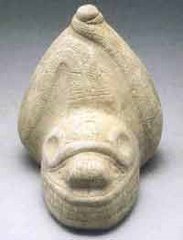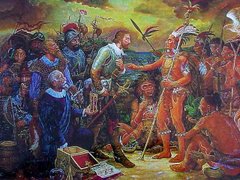Did You Know: Haiti is one of the ancient Taino names for the island the Spaniards named Hispaniola, which is today spilt between what is now the Dominican Republic and Haiti. Other words include Ayiti, Kiskeia, and Bohio. Haiti is said to mean "Highlands." - UCTP Taino News © 2010
Thursday, May 27, 2010
Sunday, April 18, 2010
Guarokuia

Did You Know: In 1519 on the island of Kiskeia (Dominican Republic) a Kasike named Guarokuia led a rebellion against the Spanish colonizers that lasted until 1533. As a result of this major defeat for the Spanish Crown the first treaty between Indigenous Peoples and a European Power was signed in the Western hemisphere. Guarokuia and several thousand other Taino were given lands in the area known as Boya. Much earlier Guarokuia's father had died in a Spanish raid against a non-violent Indian demonstration in Jaragua and he was raised in a monastery in Santo Domingo where he received his Christian name Enriquillo. One of his mentors was Bartolome de las Casas. Guarokuia was a nephew of Kasike Anacaona and the heir to the hereditary cheifdom of Jaragua. Guarokuia also had a wife, called Mencía, later Doña Mencía due to his relations with the Spaniards. Mencia was raped by a Spaniard named Andrés de Valenzuela and when Guarokuia attempted to take the offense to the Spanish courts, he was told nothing could be done since it was the word of an Indian woman (Mencia) against that of a Spaniard. Seeing that his situation had no recourse he lead a group of loyal followers into the Bahoruco mountains and this began his historic war against the Spaniards. In 1882 a 91-year-old woman by the name of Josefa Gonzalez, who along with other neighbors affirmed that Kasike Guarokuia (Enriquillo) and his wife Mencia were buried in a tomb in the center of the church in the town of Boya. In a related story, General Don Pedro Santana who after being elected President of the Dominican Republic, assigned a pension to an "Indian" woman of Boya claiming to be a descendant of one of the other chiefs under Enriquillo. - UCTP Taino News © 2010
Thursday, March 25, 2010
Iaiama: The Pineapple
 DID YOU KNOW - The pineapple was spread by Indigenous Peoples up through South and Central America to the Caribbean before Columbus arrived. It is suggested that the fruit was originally developed in southern Brazil and Paraguay where wild relatives occur. In 1493 Columbus encountered the fruit on the island of Guadaloupe and carried it back to Spain. The pineapple was soon distributed around the world on sailing ships that carried it for protection against scurvy. The Spanish introduced it into the Philippines and possibly to Hawaii and Guam early in the 16th Century. The pineapple reached England in 1660 and began to be grown in greenhouses around 1720. In the Taino language the pineapple is called Iaiama (Yayama). – UCTP Taino News © 2010
DID YOU KNOW - The pineapple was spread by Indigenous Peoples up through South and Central America to the Caribbean before Columbus arrived. It is suggested that the fruit was originally developed in southern Brazil and Paraguay where wild relatives occur. In 1493 Columbus encountered the fruit on the island of Guadaloupe and carried it back to Spain. The pineapple was soon distributed around the world on sailing ships that carried it for protection against scurvy. The Spanish introduced it into the Philippines and possibly to Hawaii and Guam early in the 16th Century. The pineapple reached England in 1660 and began to be grown in greenhouses around 1720. In the Taino language the pineapple is called Iaiama (Yayama). – UCTP Taino News © 2010
Labels:
Guadaloupe,
Iaiama,
pineapple,
Taino,
Taino Nation,
Yayama
Thursday, February 04, 2010
Canadian First Nations Recognize Taino Treaty
DID YOU KNOW - A peace treaty signed in 1533 in the Caribbean between Taino Kasike Guarokuia (Enriquillo/Henri) and a representative of the King of Spain was recognized as the “first international treaty in the Americas between Indigenous people and Europeans" in a resolution by over 100 delegates to the Assembly of First Nations (AFN) National Treaty Conference, held in Yellowknife, Northwest Territories on Oct. 28, 1998. The AFN resolution recommended recognition of the Taino-Spanish treaty to the United Nations rapporteur, Miguel Alfonso Martinez of Cuba, who was completing his final report on treaties with Indigenous peoples around the world. One fourth of Canada's Indian chiefs attended the conference, which discussed national and international treaty implications and strategies. The resolution, moved by Akaitcho Territory Government Grand Chief Felix Lockhart and seconded by Chief Fred Sangris (Yellowknives Dene), reads in part: "AFN recommends that the "1533 Bahoruco Treaty” be recognized as the first Treaty in the Americas between Indigenous Peoples and Europeans in the Final Report of the U.N. Special Rapporteur.” - UCTP Taino News © 2010
Friday, January 15, 2010
Taino Recognition

DID YOU KNOW: The United Confederation of Taino People is recognized by the U.S. Congress, U.S. Census Bureau, USA.gov, and several U.S. State and local governments and agencies. In Boriken (Puerto Rico), the Confederation is recognized by the Municipality of Utuado and the Puerto Rican House of Representatives. The work of Confederation is recognized by the Government of Canada and by inter-governmental organizations such as the United Nations and Organization of American States (OAS). In the promotion of indigenous Taino sovereignty, the UCTP has also entered into treaties with Caribbean Indigenous Governments and Tribal Organizations in Dominica, Trinidad, Barbados, and Bermuda as well as with related South American mainland communities in Venezuela and Guyana. - UCTP Taino News ©2010
Thursday, December 17, 2009
The Caribbean

Did You Know: The word “Caribbean” is said to be derived from the name of one of the dominant indigenous (Amerindian) groups in the region at the time of European contact during the late 15th century, the Caribs. While their continues to be debate among scholars as to the origin of the word, at least one of the communities currently identified as "Carib" call themselves Kalinago. The island of Boriken (Puerto Rico) itself was also identified as Carib in some old maps. Some of the other Indigenous Nations identified in the region are Arawak, Ciboney, Galibi, Garifuna, Igneri, Lucayan, and the Taino. - - UCTP Taino News © 2009
Subscribe to:
Posts (Atom)







